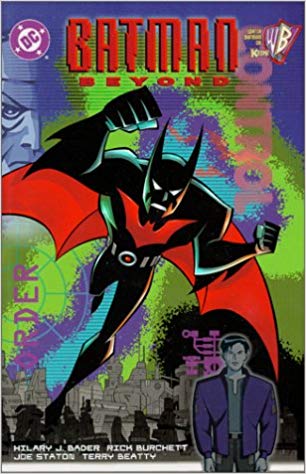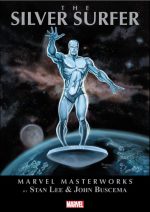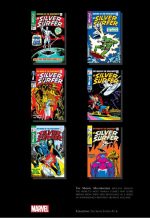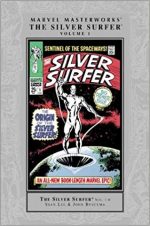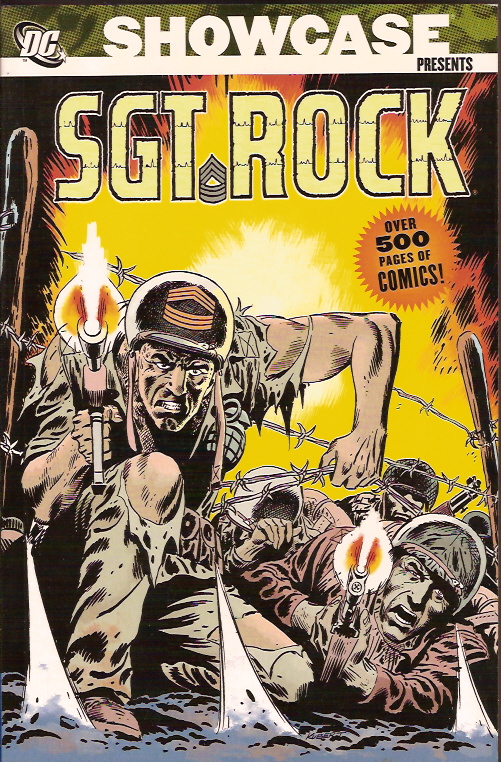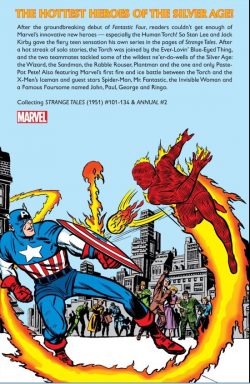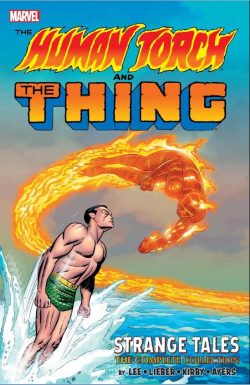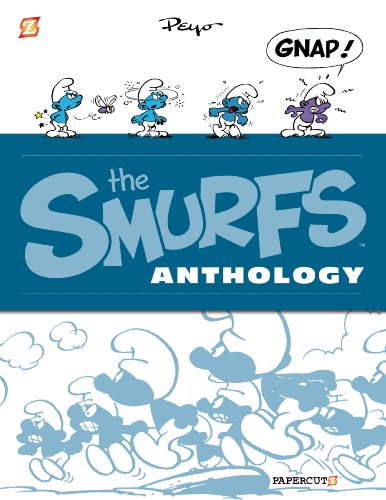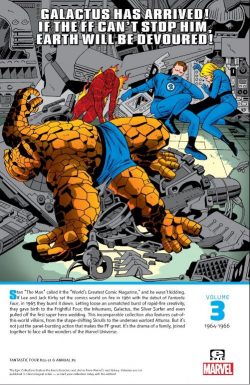
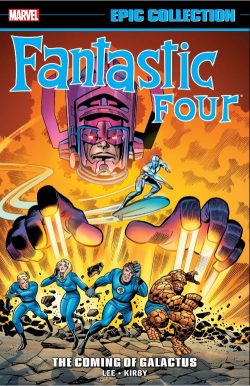
By Stan Lee & Jack Kirby with Chic Stone, Vince Colletta, Frank Giacoia, Joe Sinnott and various (Marvel)
ISBN: 978-1-3029-1331-1 (TPB)
Concocted by Stan Lee, Jack Kirby, George Klein & Christopher Rule, Fantastic Four #1 (bi-monthly and cover-dated November 1961) was crude: rough, passionate and uncontrolled excitement.
Thrill-hungry kids pounced on it and the raw storytelling caught a wave of change starting to build in America. It and succeeding issues changed comicbooks forever.
This full-colour compendium – also available as a digital download – collects issues 33-51 plus the third giant-sized Annual (spanning December 1964 to June 1966): astonishing tales and progressive landmarks as Stan & Jack cannily built on that early energy to consolidate the FF as the leading title and most innovative series of the era.
As seen in the ground-breaking premier issue, maverick scientist Reed Richards, his fiancée Sue Storm, their close friend Ben Grimm and Sue’s teenaged brother survived an ill-starred private space-shot after Cosmic Rays penetrated their ship’s inadequate shielding and mutated them all.
Richards’ body became elastic, Sue gained the power to turn invisible, Johnny Storm could turn into living flame and tragic Ben devolved into a shambling, rocky freak.
Here the wonderment resumes
Supplemented by a glorious Kirby & Chic Stone ‘Prince Namor Pin-up’, the wonderment begins ‘Side-by-Side with Sub-Mariner!’, bringing the aquatic anti-hero one step closer to his own series as the team lend surreptitious aid to the embattled undersea monarch against deadly barbarian Attuma who makes his debut in FF #33.
In ‘A House Divided!’, the team are nearly destroyed by Mr. Gregory Hungerford Gideon, the power-hungry “Richest Man in the World†after which (and following a wry ‘Yancy Street Pin-Up’), ‘Calamity on the Campus!’ sees the team visit Reed’s old Alma Mater in a tale designed to pander to the burgeoning college fan-base Marvel was assiduously cultivating.
Incorporating a cameo role for then prospective college student Peter Parker, the rousing yarn brings back demon alchemist Diablo whilst introducing the monstrous misunderstood homunculus Dragon Man. Fantastic Four #36 premiered the team’s theoretical nemeses ‘The Frightful Four’: a team of villains comprising The Wizard, Sandman, Trapster (he was still Paste Pot-Pete here, but not for much longer) plus enigmatic new character Madame Medusa, whose origins were to have a huge impact on the heroes in months to come…
Most notable in this auspicious, action-packed, but inconclusive, duel is the announcement after many months of Reed and Sue’s engagement – in itself a rare event in the realm of comicbooks.
Issue #37 finds the team spectacularly travelling to the homeworld of the shape-shifting Skrulls in search of justice or vengeance (for Sue and Johnny’s recently-murdered father) in ‘Behold! A Distant Star!’ They return only to be ‘Defeated by the Frightful Four!’ in #38: a sinister sneak attack and catastrophic clash of opposing forces with a startling cliff-hanger that marked Chic Stone’s departure in suitably epic manner.
Frank Giacoia – under the pseudonym Frank Ray – stepped in to ink #39’s ‘A Blind Man Shall Lead Them!’ wherein a suddenly-powerless Fantastic Four are targeted by an enraged Doctor Doom with only sightless vigilante Daredevil offering a chance to keep them alive.
The tale concludes in #40 with ‘The Battle of the Baxter Building’ as Vince Colletta assumes the inking duties for a bombastic conclusion that perfectly displays the undeniable power, overwhelming pathos and indomitable heroism of the brutish Thing.
A new era of fantastic suspense begins with the first chapter of a tense and traumatic trilogy in which the other FF brainwash the despondent and increasingly isolated Thing: turning him against his former team-mates.
It starts with ‘The Brutal Betrayal of Ben Grimm!’, continues in rip-roaring fashion as ‘To Save You, Why Must I Kill You?’ pits the monster’s baffled former comrades against their best friend and the world’s most insidious villains before concluding in bombastic glory with #44’s ‘Lo! There Shall be an Ending!’
After that Colletta signed off by inking the most crowded Marvel story yet conceived: Fantastic Four Annual #3. Cover-dated November 1965, it famously features every hero, most of the villains and lots of ancillary characters in the company pantheon (such as teen-romance stars Patsy Walker & Hedy Wolf and even Stan & Jack themselves).
‘Bedlam at the Baxter Building!’ spectacularly celebrates the Richards-Storm nuptials, despite a massed attack by an army of baddies mesmerised by the diabolical Doctor Doom. In its classical simplicity it signalled the end of one era and the start of another…
FF #44 was also landmark in so many ways. Firstly, it saw the arrival of Joe Sinnott as regular inker: a skilled brush-man with a deft line and a superb grasp of anatomy and facial expression, and an artist prepared to match Kirby’s greatest efforts with his own. Some inkers had problems with just how much detail the King would pencil in; Sinnott relished it and the effort showed. What was wonderful now became incomparable…
‘The Gentleman’s Name is Gorgon!’ introduces a mysterious powerhouse with ponderous metal hooves instead of feet, a hunter implacably stalking Medusa. She then entangles the Human Torch – and thus the whole team – in her frantic bid to escape, and that’s before the monstrous android Dragon Man shows up to complicate matters.
All this is merely prelude, however: with the next issue we meet a hidden race of super-beings secretly sharing Earth with us for millennia. ‘Among us Hide… the Inhumans’ reveals Medusa to be part of the Royal Family of Attilan, a race of paranormal aristocrats on the run ever since a coup deposed the true king.
Black Bolt, Triton, Karnak and the rest would quickly become mainstays of the expanding Marvel Universe, but their bewitching young cousin Crystal and her giant teleporting dog Lockjaw (“who’s a Goo-hood Boh-oy?â€) were the real stars here. For young Johnny it is love at first sight, and Crystal’s eventual fate would greatly mature his character, giving him a hint of angst-ridden tragedy that resonated greatly with the generation of young readers who were growing up with the comic…
‘Those Who Would Destroy Us!’ and ‘Beware the Hidden Land!’ (FF#46 – 47) see the team join the Inhumans as Black Bolt struggles to take back the throne from his bonkers brother Maximus the Mad, only to stumble into the usurper’s plan to wipe “inferior†humanity from the Earth.
Ideas just seem to explode from Kirby at this time. Despite being halfway through one storyline, FF #48 trumpeted ‘The Coming of Galactus!’ so the Inhumans saga is swiftly wrapped up by page 6, with the entire clandestine race sealed behind an impenetrable dome called the Negative Zone (later retitled the Negative Barrier to avoid confusion with the gateway to sub-space that Reed worked on for years).
Meanwhile, a cosmic entity approaches Earth, preceded by a gleaming herald on a surfboard of pure cosmic energy…
I suspect this experimental – and vaguely uncomfortable – approach to narrative mechanics was calculated and deliberate, mirroring the way TV soap operas were increasingly delivering their interwoven storylines, and used as a means to keep readers glued to the series.
They needn’t have bothered. The stories and concepts were enough…
‘If this be Doomsday!’ sees planet-eating Galactus setting up shop over the Baxter Building despite the team’s best efforts, whilst his cold and shining herald has his humanity accidentally rekindled by simply conversing with the Thing’s blind girlfriend Alicia Masters.
Issue #50’s ‘The Startling Saga of the Silver Surfer!’ then concludes the epic in grand style as the reawakened ethical core of the Surfer and heroism of the FF buy enough time for Richards to literally save the world with a boldly-borrowed Deus ex Machina gadget…
Once again, the tale ends in the middle of the issue, and the remaining half concentrating on the team getting back to “normalâ€. To that extent, Johnny finally enrols at Metro College, desperate to forget lost love Crystal and his unnerving jaunts to the ends of the universe.
On his first day, the lad meets imposing and enigmatic Native American Wyatt Wingfoot, destined to become his greatest friend…
That would be a great place to stop but there’s one last titanic story treat: one many fans consider the greatest single FF story ever. Illustrated by Kirby and inked by Sinnott, ‘This Man… This Monster!’ finds Ben’s grotesque body usurped and stolen by a vengeful, petty-minded scientist with a grudge against Reed Richards. The anonymous boffin subsequently discovers the true measure of his unsuspecting intellectual rival and pays a fateful price for his envy…
Topped off with a swathe of enticing house ads, pages of original art (including Kirby’s astounding collage pieces), contemporary apparel art designs and painted Kirby/Dean White covers to previous compilations, this tome teems with tales of unmatched imagination and innovation that cemented Marvel’s dominance and confirmed that they were crafting a comics empire.
The verve, conceptual scope and sheer enthusiasm shines through on every page and the wonder is there for you to share. If you’ve never thrilled to these spectacular sagas then this book of marvels is the perfect key to another – far brighter – world and time.
© 1964, 1965, 1966, 2018 Marvel Characters, Inc. All rights reserved.



